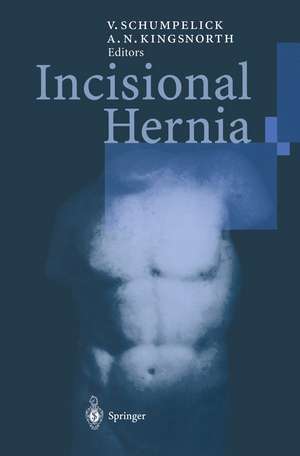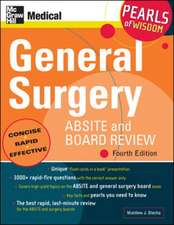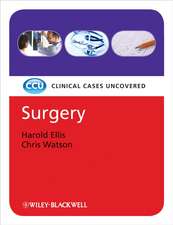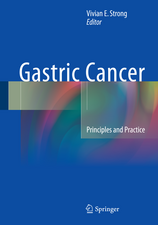Incisional Hernia
Editat de Volker Schumpelick, Andrew N. Kingsnorthen Limba Engleză Paperback – 25 sep 2011
Preț: 729.06 lei
Preț vechi: 767.42 lei
-5% Nou
Puncte Express: 1094
Preț estimativ în valută:
139.52€ • 151.50$ • 117.20£
139.52€ • 151.50$ • 117.20£
Carte tipărită la comandă
Livrare economică 22 aprilie-06 mai
Preluare comenzi: 021 569.72.76
Specificații
ISBN-13: 9783642642678
ISBN-10: 3642642675
Pagini: 540
Ilustrații: XXV, 511 p.
Dimensiuni: 155 x 235 x 28 mm
Greutate: 0.75 kg
Ediția:Softcover reprint of the original 1st ed. 1999
Editura: Springer Berlin, Heidelberg
Colecția Springer
Locul publicării:Berlin, Heidelberg, Germany
ISBN-10: 3642642675
Pagini: 540
Ilustrații: XXV, 511 p.
Dimensiuni: 155 x 235 x 28 mm
Greutate: 0.75 kg
Ediția:Softcover reprint of the original 1st ed. 1999
Editura: Springer Berlin, Heidelberg
Colecția Springer
Locul publicării:Berlin, Heidelberg, Germany
Public țintă
ResearchDescriere
All general surgeons, and especially hernia surgeons, will benefit from this book. It contains a complete update on the research and pathogenesis of the incisional hernia. The volume describes all important diagnostic and therapeutic procedures and evaluates the appropriate use of each procedure for each particular case. Pitfalls and unresolved issues are discussed in depth, and experts of international standing weigh in on each topic.
Cuprins
I Anatomy of the Abdominal Wall.- 1 Descriptive Anatomy.- 1.1 Skin.- 1.1.1 Surgical Applications.- 1.2 Subcutaneous Tissue.- 1.2.1 Vascular Supply of the Skin and Subcutaneous Fat.- 1.2.2 Surgical Applications.- 1.3 Surgical Anatomy of the Umbilical Region.- 1.4 Flat Muscles of the Anterior Abdominal Wall and the Rectus Abdominis and Pyramidalis Muscles.- 1.4.1 External Oblique Fascia (Innominate Fascia of Gallaudet).- 1.4.2 External Oblique Aponeurosis.- 1.4.3 Inguinal (Poupart’s) Ligament.- 1.4.4 Ligament of Gimbernat (Lacunar Ligament).- 1.4.5 Internal Oblique Muscle and Aponeurosis.- 1.4.6 Transversus Abdominis Muscle and Aponeurosis.- 1.4.7 Arch of the Internal Oblique and Transversus Abdominis Muscles.- 1.4.8 Conjoined Area.- 1.4.9 Rectus Abdominis Muscle and its Sheath.- 1.4.10 Linea Alba.- 1.5 Fascia Transversalis.- 1.5.1 Thickenings of the Fascia Transversalis.- 1.6 Spaces.- 1.6.1 Vascular Space.- 1.6.2 Space of Bogros.- 1.7 Vascularization of the Muscles.- 1.8 Innervation of the Abdominal Wall.- 1.8.1 Thoracoabdominal Nerves.- 1.8.2 Ilioinguinal Nerve.- 1.8.3 Iliohypogastric Nerve.- 1.8.4 Genitofemoral Nerve.- 1.8.5 Surgical Applications.- 1.9 Peritoneum.- 1.10 Fossae of the Anterior Abdominal Wall.- 1.11 Myopectineal Orifice of Fruchaud.- 1.12 Cooper’s Ligament.- 1.13 Femoral Canal and Femoral Sheath.- 1.14 “Good Stuff”.- 1.15 Discussion.- References.- 2 Functional Anatomy.- 2.1 Upper Abdominal Zone Herniation.- 2.2 Incidence.- 2.3 Pathological Anatomy.- 2.4 Repair Techniques.- 2.5 Condensation and Sling of the Fascia Transversalis.- 2.6 Discussion.- References.- 3 Surgical Anatomy.- 3.1 Introduction.- 3.2 Skin and Subcutis.- 3.3 Muscles of the Abdominal Wall.- 3.3.1 Rectus Abdominis Muscle.- 3.3.2 Oblique External Muscle of the Abdomen.- 3.3.3 Oblique Internal Muscle of the Abdomen.- 3.3.4 Transverse Muscle of the Abdomen.- 3.4 Fascial Structures.- 3.4.1 Sheath of Rectus Abdominis Muscle.- 3.4.2 Linea Alba.- 3.4.3 Fascia Transversalis.- 3.5 Preperitoneal Space.- 3.6 Inguinal Falx (or Conjoined Tendon or Henle’s Ligament).- 3.7 Interfoveolar (Hesselbach’s) Ligament.- 3.8 Discussion.- References.- II Wound Healing.- 4 Fascial Metabolic Defects.- 4.1 Introduction.- 4.2 Personal Observations.- 4.3 Hypothesis.- 4.4 Pulmonary Emphysema.- 4.5 Metastatic Emphysema.- 4.6 Supporting Data.- 4.7 Proteolysis in Patients with Aneurysm.- 4.8 Congenital and Genetic Influences.- 4.9 Conclusion.- 4.10 Summary.- 4.11 Discussion.- References.- 5 Growth Factors and Hernia.- 5.1 Function.- 5.2 Availability.- 5.3 Experimental Findings.- 5.4 Outlook.- 5.5 Discussion.- References.- III Abdominal Wall Defects.- 6 Primary Hernia.- 6.1 Epigastric Hernia.- 6.2 Anatomy.- 6.3 Umbilical Hernia.- 6.4 Infantile Umbilical Hernia.- 6.5 Acquired Umbilical Hernia.- 6.6 Para-umbilical Hernia.- 6.7 Umbilical Hernia in Adults.- 6.8 Spigelian Hernia.- 6.9 Obturator Hernia.- 6.10 Lumbar Hernia.- 6.11 Discussion.- 7 Nonhernial Defects.- 7.1 Tumor Resection.- 7.2 Trauma.- 7.3 Necrotizing Fasciitis.- 7.4 Laparostomy.- 7.5 Radiotherapy.- 7.6 Donor Defect After a Transverse Rectus Abdominis Musculocutaneous Flap.- 7.7 Prune Belly Syndrome.- 7.8 Congenital Abdominal Wall Necrosis.- 7.9 Discussion.- References.- 8 Acute Wound Failure.- 8.1 Incidence.- 8.2 Pertinent Aspects of Fascial Healing.- 8.3 Choice of Incision.- 8.4 Mechanisms.- 8.5 Choice of Closure.- 8.6 Risk Factors.- 8.7 Role of Infection.- 8.8 Postoperative Increases in Intra-abdominal Pressure.- 8.9 Summary.- 8.10 Discussion.- References.- 9 Natural History and Patient-Related Factors.- 9.1 Introduction.- 9.2 Natural History of Wound Healing.- 9.3 Wound Infection.- 9.4 Patient-Related Risk Factors.- 9.5 Increased Intra-abdominal Pressure.- 9.6 Drugs.- 9.7 Discussion.- References.- 10 Diagnosis of Abdominal Wall Defects.- 10.1Sonography.- 10.1.1 Sonographic Anatomy of the Abdominal Wall.- 10.1.2 Sonographic Differential Diagnosis of Pathological Findings.- 10.1.3 Preoperative Investigations.- 10.2 Sonographic Criteria for Hernias.- 10.2.1 Epigastric Hernia.- 10.2.2 Inguinal Hernia.- 10.2.3 Femoral Hernia.- 10.2.4 Spigelian Hernia.- 10.2.5 Lumbar Hernia.- 10.2.6 Incisional Hernia.- 10.2.7 Umbilical Hernia.- 10.3 Further Anomalies.- 10.3.1 Metastasis.- 10.3.2 Lipoma.- 10.3.3 Lyphoma.- 10.3.4 Endometriosis.- 10.3.5 Abdominal Wall Relaxation.- 10.3.6 Varicose Nodules.- 10.3.7 Postoperative Investigations.- 10.3.8 Hematoma.- 10.3.9 Seroma.- 10.3.10 Abscess.- 10.3.11 Hematoma of the Rectus Sheath.- 10.3.12 Wound Rupture (Burst Abdomen).- 10.4 Results.- 10.4.1 Sonography.- 10.4.2 Computed Tomography and Magnetic Resonance Imaging.- 10.5 Conclusion.- 7.6 Discussion.- References.- IV Principles of Repair.- 11 Preparation of Patients for Hernia Surgery.- 11.1 General Aspects.- 11.2 Progressive Pneumoperitoneum.- 11.3 Pathophysiology.- 11.4 Technique.- 11.5 Results.- 11.6 Conclusion.- 11.7 Discussion.- References.- 12 Augmentation with Autologous Material.- 12.1 Introduction.- 12.2 Technical Aspects.- 12.2.1Cutisplasty.- 12.2.2 Tensor Fasciae Latae Transposition Flap.- 12.2.3 Free Transplanted Myocutaneous Flap — Latissimus Dorsi Free Flap.- 12.3 Summary.- 12.4 Discussion.- References.- 13 Biomaterials — Classification,Technical and Experimental Aspects.- 13.1 Infection.- 13.2 Seroma.- 13.3 Intestinal Adhesions and Fistula Formations.- 13.4 Shrinkage of the Prosthesis.- 13.4.1 Collapse of the Prosthetic Plug (Mesh Plug).- 13.4.2 Shrinkage of the Mesh Patch.- 13.5 Conclusion.- 13.6 Discussion.- References.- 14 Biocompatibility of Biomaterials — Clinical and Mechanical Aspects.- 14.1 Introduction.- 14.2 Three-Dimensional Stereography.- 14.3 Intra-abdominal Pressure.- 14.4 Fascia and Suture Tearout Force.- 14.5 Tension Strength.- 14.6 Tensile Strength.- 14.7 Mechanical Aspects of Biomaterial.- 14.8 Textile Analysis Results.- 14.9 Discussion.- References.- 15 Biomaterials — Experimental Aspects.- 15.1 Textile Characteristics.- 15.2 Experimental Aspects.- 15.2.1 Mechanical Testing.- 15.2.2 Histology.- 15.2.3 Conclusion.- 15.3 Adhesions and Fistulas.- 15.3.1 Clinical Prevention.- 15.4 Infection.- 15.5 Mesh Shrinkage.- 15.6 Meshes and Tumorgenesis.- 15.7 Summary.- 15.8 Discussion.- References.- 16 Biocompatibility of Biomaterials — Histological Aspects.- 16.1 Current Status of Mesh Research.- 16.2 Concept of Low- and Heavy-Weight Surgical Meshes.- 16.3Tissue Response in Low- Versus Heavy-Weight Meshes.- 16.4 Cellular Response in Low- Versus Heavy-Weight Meshes.- 16.5 Short- and Long-Term Biocompatibility of Surgical Meshes.- 16.6 Risk of Foreign Body Carcinogenesis.- 16.7 General Histological Principles for the Future Development of Surgical Meshes.- 16.8 Discussion.- References.- 17 Biomaterials — Principles of Implantation.- 17.1 Choice of the Prosthesis.- 17.2 Site of Implantation.- 17.2.1 Intraperitoneal Positioning.- 17.2.2 Premuscular Positioning.- 17.2.3 Retromuscular Prefascial Prosthesis.- 17.3 Fixation of the Prosthesis.- 17.4 Postoperative Care.- 17.4.1 Early Postoperative Infection.- 17.4.2 Late Postoperative Infection.- 17.5 Results.- 17.6 Conclusion.- 17.7 Discussion.- References.- V Closure of Laparotomy.- 18 Long- Versus Short-Term Absorbable Sutures.- 18.1 Introduction.- 18.2 Wound Dehiscence.- 18.3 Wound Infection.- 18.4 Incisional Hernia.- 18.5 Conclusion.- 18.6 Discussion.- References.- 19 Absorbable Versus Nonabsorbable Suture for Laparotomy Closure.- 19.1 Requirements for the Ideal Suture.- 19.2 Current Sutures: A Sampling.- 19.3 Current Sutures: Randomized Trials.- 19.4 Summary.- 19.5 Discussion.- References.- 20 Experience with Continuous Absorbable Suture for Laparotomy Closure.- 20.1 Introduction.- 20.2 Patients and Methods.- 20.3 Results.- 20.3.1 Early Complications.- 20.3.2 Late Complications.- 20.4 Conclusion.- 20.5 Summary.- 20.6 Discussion.- References.- 21 Continuous Closure of Laparotomy Incisions: Aspects of Suture Technique.- 21.1 Introduction.- 21.2 Suture Length to Wound Length Ratio.- 21.3 Stitch Length.- 21.4 Tension.- 21.5 Modifying Surgical Technique.- 21.6 Knots.- 21.7 Recommendations.- 21.8 Discussion.- 21.2 References.- 22 Closure of the Abdomen in Acute Wound Failure.- 22.1 Reducing the Incidence of Burst Abdomen.- 22.2 Repairing Burst Abdomen to Reduce the Incisional Hernia Rate Postoperatively.- 23.3 Discussion.- References.- VI Repair of Primary Hernia.- 23 Surgery of Umbilical, Epigastric and Spigelian Hernia.- 23.1 Umbilical Hernias.- 23.1.1 Omphalocele.- 23.1.2 Infantile Umbilical Hernias.- 23.1.3 Paraumbilical Hernias.- 23.1.4 Umbilical Hernia in Adults and Acquired Umbilical Hernias.- 23.2 Epigastric Hernias.- 23.3 Spigelian Hernias.- 23.4 Discussion.- References.- VII Repair of Incisional Hernia.- Mesh-Free Techniques.- 24 Indication and Limitations of Suture Closure — Significance of Relaxing Incisions.- 24.1 Technical Factors.- 24.2 Biological Factors.- 24.2.1 Presurgical Aspects.- 24.2.2 Perisurgical Aspects.- 24.2.3 Incisional Hernia Classification.- 24.2.4 General Remarks.- 24.3 Auxiliary Methods.- 24.3.1 Pneumoperitoneum.- 24.3.2 Relaxing Incisions.- 24.4 Discussion.- References.- 25 Significance of Fascia Doubling in the Management of Incisional Hernia.- 25.1 Introduction.- 25.2 Technique of Fascia Doubling.- 25.3 Preference for Fascia Doubling in Incisional Hernia Repair.- 25.4 Long-Term Results of Fascia Doubling for Primary and Recurrent Incisional Hernia Repair.- 25.5 Conclusion.- 25.6 Discussion.- References.- Mesh Techniques.- 26 Polypropylene Mesh Repair of Incisional Hernia: Marlex and Prolene Mesh.- 26.1 Incision and Dissection.- 26.2 Preparation of Mesh.- 26.3 Insertion of Mesh.- 26.4 Closing the Defect.- 26.5 Extraperitoneal, Subaponeurotic, Sublay Mesh Placement.- 26.6 Deciding Which Technique to Use.- 26.7 Discussion.- References.- 27 Prosthetic Incisional Hernioplasty: Indications and Results.- 27.1 Materials.- 27.2 Prostheses.- 27.3 Indications for Mesh.- 27.4 Mortality and Complications.- 27.5 Recurrences.- 27.6 Conclusion.- 27.7 Discussion.- References.- 28 Intermediate Follow-Up Results of Sublay Polypropylene Repair in Primary and Recurrent Incisional Hernias.- 28.1 Indication for Meshes.- 28.2 Implantation Technique.- 28.3 Mesh Material.- 28.4 Conclusion.- 28.5 Discussion.- References.- 29 Polyester Mesh for Incisional Hernia Repair.- 29.1 History.- 29.2 Material and Methods.- 29.3 Conclusion.- 29.4 Discussion.- References.- 30 Polytetrafluoroethylene Repair of Incisional Hernia: Development and Results.- 30.1 Introduction.- 30.2 Physical Modification.- 30.3 Macroscopic Structural Modification.- 30.3 Microscopic Structural Modification.- 30.5 Chemical Modification.- 30.6 Double-Layer Principle.- 30.7 Future Developments.- 30.8 Conclusion.- 30.9 Discussion.- References.- 31 Plastic Reconstruction of Abdominal Wall Defects.- 31.1 Introduction.- 31.2 Material and Methods.- 31.3 Results.- 31.4 Conclusion.- 31.5 Discussion.- References.- VIII Recurrent Inguinal Hernia.- Suture Repair.- 32 Experience of the Shouldice Clinic in Recurrent Inguinal Hernia Repair.- 32.1 Introduction.- 32.2 Background (Past).- 32.3 Background (Present).- 32.4 Conclusion.- 32.5 Discussion.- References.- 33 Shouldice Repair for Recurrent Inguinal Hernia — A Ten-Year Follow-Up.- 33.1 Introduction.- 33.2 Patients and Methods.- 33.3 Results.- 33.4 Conclusion.- 33.5 Discussion.- References.- 34 Suture Repair of Recurrent Inguinal Hernia — A Review of the Literature.- 34.1 Introduction.- 34.2 Results of the Open Approach.- 34.2.1 Bassini Technique.- 34.2.2 McVay Procedure.- 34.2.3 Transversalis Repair.- 34.2.4 Shouldice Technique.- 34.2.5 Lichtenstein Technique.- 34.2.6 Mesh Plug.- 34.2.7 Preperitoneal Mesh Layer Using the Inguinal Approach (Transinguinal Preperitoneal Prosthesis/Rives Procedure).- 34.2.8 Preperitoneal Mesh Layer Using the Extrainguinal Approach (Wantz Technique).- 34.2.9 Stoppa Procedure.- 34.3 Conclusion.- 34.4 Discussion.- References.- 35 Causes and Treatment of Recurrent Inguinal Hernias.- 35.1 Treatment.- 35.2 Technique.- 35.3 Discussion.- References.- 36 European Experience with the Lichtenstein Repair for Recurrent Inguinal Hernia.- 36.1 Introduction.- 36.2 Lichtenstein Plug Operation.- 36.3 Lichtenstein Patch Repair.- 36.4 Conclusion.- 36.5 Discussion.- 36.4 References.- 37 Transinguinal Preperitoneal Prosthesis Placement Under Local Anesthesia — Management and Follow-Up of 100 Patients.- 37.1 Development and Technique.- 37.2 Local Anesthesia.- 37.3 Patients.- 37.4 Results.- 37.5 Comments.- 37.6 Discussion.- References.- 38 Experience with the Mesh Umbrella Repair of Recurrent Inguinal Hernia.- 38.1 Introduction.- 38.2 Personal Experience.- 38.2.1 Case Rate.- 38.2.2 Perioperative Patient Management.- 38.2.3 Indication.- 38.2.4 Methodology.- 38.2.5 Results.- 38.2.6 Comparison of Conventional Shouldice Versus the Flatt Netting and Mesh Umbrella Techniques.- 38.3 Conclusion.- 38.4 Discussion.- 39 Prosthetic Repair of Recurrent Groin Hernias.- 39.1 Introduction.- 39.2 Treatment.- 39.3 Results.- 39.4 Discussion.- References.- 40 Indications and Results of Open Preperitoneal Mesh Repair for Recurrent Groin Hernia.- 40.1 Introduction.- 40.2 Patients and Methods.- 40.3 Results.- 40.4 Techniques.- 40.5 Comments.- 40.6 Discussions.- References.- Laparoscopic and Endoscopic Techniques.- 41 Laparoscopic Treatment of Recurrent Hernias.- 41.1 Introduction.- 41.2 Evolution of the Preperitoneal Approach.- 41.3 Causes of Recurrence After Anterior Herniorrhaphy.- 41.3.1 Indirect Recurrence.- 41.3.2 Direct Recurrence.- 41.3.3 Femoral Recurrence.- 41.4 Causes of Recurrence After Open or Laparoscopic Preperitoneal Herniorrhaphy.- 41.4.1 Incomplete Dissection.- 41.4.2 Inadequate Mesh Size.- 41.4.3 Inadequate Overlap.- 41.4.4 Mesh Slitting.- 41.4.5 Missed Hernias.- 41.4.6 Mesh Displacement.- 41.5 Transabdominal Preperitoneal Repair (TAPP).- 41.6 Totally Extraperitoneal Repair (TEP.- 41.7 Comments.- 41.8 Conclusion.- 41.9 Discussion.- References.- 42 Endoscopic Repair: Totally Endoscopic Preperitoneal Prosthesis in Recurrent Inguinal Hernia.- 42.1 Aarberg’s Strategy for Inguinal Hernia Repair.- 42.2 Operative Technique.- 42.3 Aarberg’s Results.- 41.9 Conclusion.- 41.9 Discussion.- References.- IX Pitfalls,Complications and Quality Control.- 43 Complications of the Suture Repair of Incisional Hernia.- 43.1 Introduction.- 43.2 Scar.- 43.3 Buttonhole Herniation.- 43.4 Incisional Herniation After Resection of Abdominal Aortic Aneurysm.- 43.5 Personal Observations.- 43.6 Supporting Data.- 43.7 Congenital and Genetic Influences.- 43.8 Tissue Reinforcement.- 43.9 Plastic Reinforcement.- 43.10 Summary.- 43.11 Discussion.- References.- 44 Pitfalls and Complications in Open Recurrent Hernia Repair.- 44.1 Clinical Setting.- 44.2 Surgical Setting.- 44.3 Complications.- 44.3.1 Organ Involvement.- 44.3.2 Infections.- 44.3.3 Prostheses.- 44.3.4 Recurrences.- 44.4 Conclusion.- 44.5 Discussion.- References.- 45 Complications of the Laparoscopic-Endoscopic Approach in Recurrent Inguinal Hernia Repair.- 45.1 Methods of Repair.- 45.2 Results.- 45.3 Repair of Recurrences.- 45.4 Comments.- 45.5 Discussions.- References.- 46 Quality Control in Hernia Surgery: The Swedish Experience.- 46.1 Recurrence Rate: Obtaining Information.- 46.2 The Swedish Hernia Register.- 46.3 Register Data and Economics.- 46.4 Register Data and Randomised Controlled Trials.- 46.5 Conclusions.- 46.6 Discussions.- References.- X Conclusion.- 47 Pannel Discussion.- 47.1 Incision.- 47.2 Closure.- 47.3 Suture Bites.- 47.4 Postoperative Activities.- 47.5 Primary Closure of Incisional Hernia.- 47.6 Relaxing Incisions.- 47.7 Mesh Repair for Incisional Hernia.- 47.8 Mesh Fixation.- 47.9 Mesh Material.- 47.10 Bowel Protection.- 47.11 Mesh Migration.- 47.12 Classification.- 47.13 Recurrent Inguinal Hernias.- 47.14 Treatment.- Appendix: Questionnaire.
Caracteristici
Update on repair of incisional hernia by experts of international standing
Current diagnostic and therapeutic procedures
Guidelines for the appropriate use of each procedure
Modern laparoscopic methods use meshes for stabilizing the abdominal wall (more than 1 million are implanted worldwide)
Discusses pitfalls and benefits of mesh techniques
Complete and critical evaluation of currently used meshes
Current diagnostic and therapeutic procedures
Guidelines for the appropriate use of each procedure
Modern laparoscopic methods use meshes for stabilizing the abdominal wall (more than 1 million are implanted worldwide)
Discusses pitfalls and benefits of mesh techniques
Complete and critical evaluation of currently used meshes








